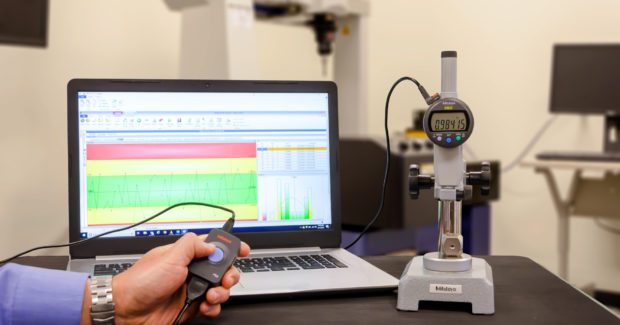QIF Adoption Lays The Foundation For A Digital Thread
A manufacturer’s ability to create a comprehensive, cost-effective digital thread is hindered by legacy and proprietary communications standards. Fortunately, the International Standards Organization is expected to approve the Quality Information Framework (QIF) by the end of the year.
Posted: July 27, 2020
BY HANY ABDEL-MOTALEB
Whatever they’re producing, all metal manufacturers face the same pressure to ensure quality across the entire supply chain. To bring order to the chaos of tracking myriad parts, part characteristics, suppliers, machine brands, and operators, manufacturers can create a digital thread using software that gathers and logs information for each part through its entire lifecycle.
If you decide to invest in such software, it’s important to choose a program that uses a digital model-based (MBD) metrology standard called the Quality Information Framework (QIF). QIF is an extensible markup language (XML)-based schema that ensures interoperability by storing data in a format that’s commonly used and understood across industries. As a result, documents containing measurements, statistics, part numbers, and serial numbers are transferrable and accessible by any software application within a company and across the supply chain.
QIF is similar to MTConnect, a protocol for retrieving information from numerically controlled machine tools that’s overseen by AMT – The Association For Manufacturing Technology, in that they both use XML technology. MTConnect, however, is concerned with process data such as usage, temperature, throughput, etc.; whereas QIF is concerned with product information: part numbers, dimensions, tolerances, measurements, statistics, quality plan, etc. QIF is free to any software developer, manufacturer, or machine tool builder. Companies that adopt QIF relieve their customers of the need to import and export data that’s in another format to machines and other software applications.
QIF was released and accepted by the American National Standards Institute (ANSI) in 2013. The Digital Metrology Standards Consortium (DMSC) has submitted the standard to the International Standards Organization (ISO) ISO/TC 184/SC 4 Industrial Data Committee the standard by the end of 2020.
Automotive, medical, metalworking and other manufacturing industries have been slow to adopt QIF standards because they have yet to be accepted into the ISO. However, a comprehensive digital thread is possible only if industries move away from legacy and proprietary standards. Otherwise, manufacturers are, in essence, mandated to use software that isn’t necessarily the best choice for their company.
The future of manufacturing is the Smart Factory, where sensors and machines gathering digital data create an integrated, streamlined, and connected enterprise. Once QIF standards get the ISO seal of approval, the last obstacle to establishing a comprehensive digital thread will be eliminated and the market will drive software interoperability that makes smart manufacturing fully possible.
Benefits Of Adopting The Framework Standard
Product recalls have become a costly and dangerous issue for the automotive industry. For example, an airbag or seatbelt failure due to poor quality can result in the loss of life and put manufacturers out of business.
The ability to track a recalled product via the digital thread provides results and statistics for measured characteristics along with who, what, when, and where the part was manufactured. The information stored in QIF documents can be sorted and searched based on universally unique identifiers (UUIDs) that make document retrieval quick, easy, and precise. UUIDs are necessary when trying to identify the source of failure from among thousands, or even millions, of measurement data points captured over several years.
In the medical industry, ensuring the surface finish on a knee replacement or other implant doesn’t cause a patient discomfort is a level of quality that cannot be compromised. QIF-supported software that follows an implant through the supply chain is vital to ascertain where things could or are going wrong, be it with the raw material supplier, the subcontractor that’s putting together the final assembly, or any supplier in between. Being able to catch issues based on transferable and searchable data means correcting course before a faulty implant is used in a surgical procedure.
For both automotive and medical manufacturers, along with many other industries, long-term archiving of data and the requirement to track certain information for a specific number of years is another important issue. Product information stored as QIF documents can help simplify and streamline this process while eliminating physical storage costs associated with paper records.
It’s common in many industries to see a dictate that requires a manufacturer to use a proprietary standard that’s supported by few software applications. Those applications lack interoperability, typically don’t fit the company’s needs very well, and can make digital data transfer difficult. These are the reasons there’s a growing interest in adopting QIF as a global product communication standard.
High-Quality Manufacturing: The Standard’s Ultimate Goal
Ultimately, manufacturers will see QIF standards simplify and improve the manufacturing process with machine-readable documents that contain results and statistics. Those documents can be used to deliver data back to a machining center to automatically set tool offsets, which leads to higher-quality parts production and a closed-loop manufacturing process that reduces costs while keeping parts in tolerance.
As we look to the future, the ability to integrate data along the supply chain to ensure higher-quality manufacturing will only become more important. The key to success is having the right software and the right standards in place to seamlessly connect partners and suppliers.

















